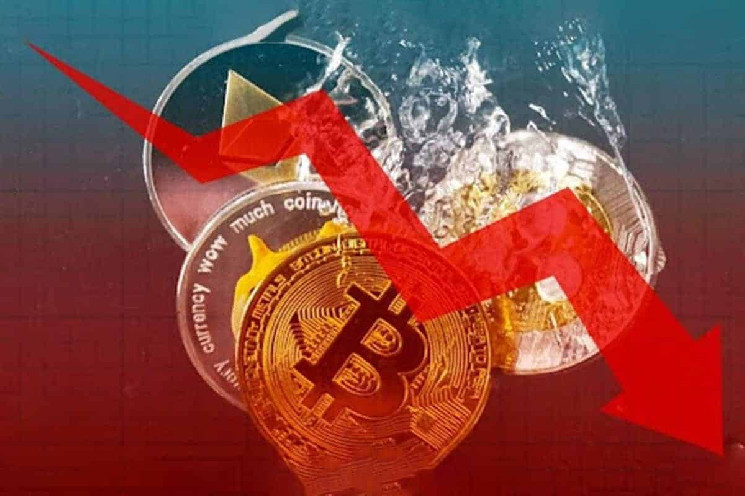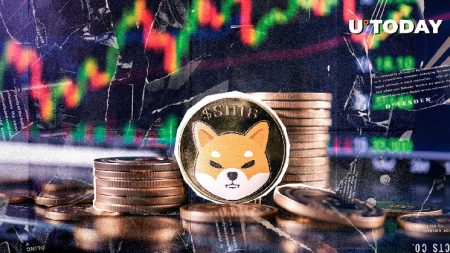The Ripple Effect of Jerome Powell’s Testimony on the Crypto Market
The cryptocurrency market has once again found itself in the grip of bearish sentiment, as prices continued to tumble on Wednesday. This downturn follows Federal Reserve Chair Jerome Powell’s recent testimony, which has sent shockwaves through the financial world. Bitcoin (BTC), the flagship cryptocurrency, saw its price drop to a low of $95,000, reigniting fears among investors about the market’s stability. Meanwhile, major altcoins like Ethereum (ETH), XRP, and Solana (SOL) also followed suit, with their prices mirroring the downward trajectory of Bitcoin. This widespread decline has left many in the crypto community on edge, as the market struggles to regain its footing.
Theenary of Powell’s remarks has been a recurring theme in recent months, as his comments on monetary policy and interest rates have consistently influenced market sentiment. Investors are particularly wary of the Federal Reserve’s stance on inflation and how it might impact the broader economy. With Bitcoin and other cryptocurrencies often viewed as risk assets, any sign of tightening monetary policy can lead to a flight of capital from the crypto market. This has been evident in the latest price movements, as the market reacts to Powell’s testimony with a mix of caution and concern.
Bitcoin’s Struggles and the Broader Market Downturn
Bitcoin’s slide to a $95,000 low has left many investors questioning whether the cryptocurrency can maintain its position as a store of value. While Bitcoin has historically been seen as a hedge against inflation, its recent performance has raised doubts about its ability to decouple from traditional financial markets. The crypto market’s correlation with equities has become increasingly evident, as both asset classes have been impacted by the same macroeconomic factors.
Ethereum (ETH), the second-largest cryptocurrency by market capitalization, has also been caught in the crossfire. Its price has been under pressure, mirroring the broader market downtrend. Similarly, other prominent altcoins like XRP and Solana (SOL) have experienced significant declines, further fueling the bearish sentiment. This widespread downturn has led to a sharp drop in market confidence, with many investors opting to err on the side of caution as they await further clues on the direction of the economy.
The timing of this market decline is particularly noteworthy, as it coincides with the upcoming release of key economic data in the United States. The Consumer Price Index (CPI) and Producer Price Index (PPI) are set to be unveiled shortly, and these reports are expected to provide further insight into the state of inflation and the overall health of the economy. Market participants are bracing themselves for the potential impact of these figures, as they could influence the Federal Reserve’s policy decisions in the coming months.
Investor Sentiment and the Role of Economic Data
The crypto market’s current volatility is reflective of the broader uncertainty in the global economy. Investors are grappling with a myriad of challenges, from rising interest rates to geopolitical tensions, and these factors are undoubtedly influencing their decisions in the crypto space. The upcoming CPI and PPI data are particularly significant, as they are likely to shape the Federal Reserve’s approach to monetary policy. Should these reports indicate that inflation remains stubbornly high, it could lead to further interest rate hikes, putting additional pressure on risk assets like cryptocurrencies.
In this environment, investors are adopting a cautious approach, with many opting to hold onto their funds rather than taking on additional risk. The crypto market’s sensitivity to macroeconomic developments has been a recurring theme in recent months, and the latest price movements are no exception. As the market waits with bated breath for the release of the CPI and PPI data, one thing is clear: the road ahead for Bitcoin, Ethereum, and other cryptocurrencies will likely be shaped by these key economic indicators.
The Role of Altcoins in the Current Market Landscape
While Bitcoin is often the focal point of discussions in the crypto space, altcoins have also been making headlines for all the wrong reasons. Ethereum, XRP, and Solana (SOL) are among the many altcoins that have seen their prices decline in recent days, highlighting the interconnectedness of the cryptocurrency market. These altcoins, which were once hailed as potential disruptors in the financial and technological sectors, are now facing significant headwinds as investors become increasingly risk-averse.
The decline of altcoins has been particularly concerning for investors who had high hopes for their growth. Many of these cryptocurrencies were expected to capitalize on the growing adoption of decentralized finance (DeFi) and other blockchain-based technologies. However, the current market environment has put a damper on these expectations, as investors prioritize capital preservation over growth opportunities. This has led to a sharp decline in trading volumes, further exacerbating the bearish sentiment in the market.
The performance of altcoins also raises questions about their long-term viability in the face of a prolonged downturn. While some altcoins have shown resilience in the past, the current market conditions are testing their mettle like never before. Investors are increasingly scrutinizing the use cases and fundamentals of these cryptocurrencies, and only those with strong underlying value propositions are likely to survive the current shakeout.
The Impact of Volatility on Crypto Investors
The crypto market’s volatility has always been a double-edged sword, offering the potential for significant gains but also posing substantial risks to investors. The latest price swings have been no exception, leaving many investors feeling uncertain about their next move. While some have chosen to hold onto their investments in anticipation of a market recovery, others have opted to liquidate their positions to minimize losses.
This dichotomy in investor behavior underscores the emotional and psychological challenges of navigating the crypto market. The rapid price swings can be both exhilarating and exhausting, particularly for those who are new to the space. The current market downturn has been particularly trying for long-term investors, as they are forced to confront the possibility of prolonged losses.
Despite these challenges, many investors remain optimistic about the future of cryptocurrencies. While the short-term outlook may be murky, the long-term fundamentals of the crypto market remain intact. The growing adoption of blockchain technology, coupled with the increasing recognition of cryptocurrencies as a legitimate asset class, provides a compelling case for their continued growth.
Navigating the Crypto Market in Uncertain Times
In light of the current market conditions, it is more important than ever for investors to adopt a cautious and informed approach. Diversification, risk management, and a long-term perspective are key strategies for navigating the crypto market’s volatility. Investors would do well to avoid making impulsive decisions based on short-term price movements and instead focus on the underlying fundamentals of the cryptocurrencies they are considering.
The upcoming CPI and PPI data will undoubtedly play a significant role in shaping the crypto market’s trajectory in the coming weeks. Should these reports indicate that inflation is under control, it could lead to a reversal of the current bearish trend. Conversely, if the data suggests that inflation remains elevated, it could result in further downward pressure on crypto prices.
In conclusion, the crypto market’s current struggles are a reflection of the broader economic uncertainties that investors are facing. While the short-term outlook may be challenging, the long-term potential of cryptocurrencies remains undiminished. As the market continues to evolve, it is essential for investors to stay informed, remain disciplined, and approach their investments with a clear-eyed perspective.
The Connection Between Crypto and Traditional Financial Markets
The cryptocurrency market’s latest downturn has once again highlighted its connection to traditional financial markets. Bitcoin, Ethereum, and other cryptocurrencies are increasingly being influenced by the same macroeconomic factors that impact equities and other risk assets. The Federal Reserve’s monetary policy decisions, inflation data, and broader economic trends are all playing a significant role in shaping the crypto market’s direction.
This interconnection has led to a growing recognition of cryptocurrencies as a legitimate asset class, albeit one that comes with unique risks and challenges. The integration of cryptocurrencies into the broader financial ecosystem has opened up new opportunities for investors, but it has also exposed them to the potential for significant volatility.
The current market environment serves as a reminder of the importance of understanding the interplay between crypto and traditional financial markets. As the global economy continues to evolve, the relationship between these two asset classes is likely to become even more pronounced. Investors who can navigate this complex landscape with a combination of knowledge, discipline, and patience are best positioned to succeed in the long term.
Looking Ahead: The Future of Cryptocurrencies in a Volatile Market
The cryptocurrency market’s future remains uncertain, as it continues to grapple with the current wave of bearish sentiment. Bitcoin’s price fluctuations, Ethereum’s challenges, and the struggles of altcoins like XRP and Solana (SOL) all serve as reminders of the market’s volatility. However, despite these challenges, there is still cause for optimism.
The growing adoption of cryptocurrencies, the advancement of blockchain technology, and the increasing recognition of their potential as a store of value all point to a promising future for the crypto market. While the short-term outlook may be clouded by macroeconomic uncertainties, the long-term fundamentals of cryptocurrencies remain strong.
Investors who are able to navigate the current market volatility with a clear-eyed perspective and a well-thought-out strategy will be well-positioned to capitalize on the opportunities that lie ahead. As the market continues to evolve, it will be essential to stay informed, remain disciplined, and approach investments with a focus on long-term growth rather than short-term gains.
In conclusion, the crypto market’s current struggles are a reminder of the challenges and opportunities that come with investing in this dynamic and rapidly evolving space. While the road ahead may be uncertain, the potential for growth and innovation remains as strong as ever. For investors who are willing to embrace the risks and rewards of cryptocurrencies, the future holds much promise.















